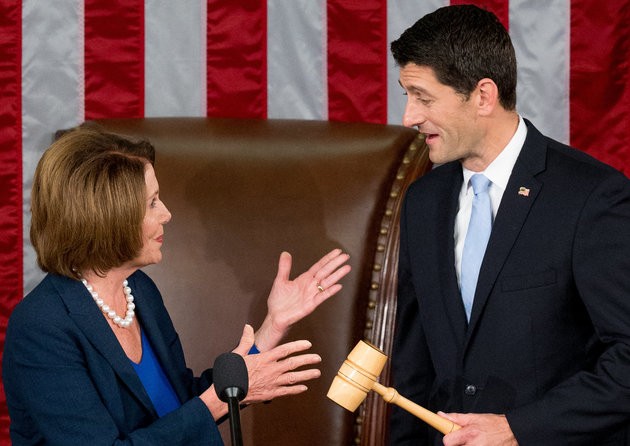Speaker Paul D. Ryan (R.-Wis.) is the Republican nominee for Speaker of the House for Tuesday’s election, facing the challenge by Minority Leader Nancy Pelosi (D.-Calif.), whose own nomination victory in November was not always certain.
Pelosi was challenged for the nomination by Rep. Timothy J. Ryan (D.-Ohio), a traditional Democrat, who took the fight to Pelosi inside the House Democratic Caucus, losing 134-63 in a vote delayed until Nov. 30.
The day of the vote, there was a furious whipping of Democratic congressmen, and going into the vote, Ryan’s people thought they had the commitments to make it so close that Pelosi would step aside — recognizing that she did not have the confidence of the caucus. But, unlike Hillary R. Clinton’s “Blue Wall,” Pelosi held on to her leadership team, the Black Congressional Caucus, female House Democrats, and all but a handful of 39 congressmen from the California delegation.
Pelosi’s last scare was the nomination fight after the Tea Party tidal wave in 2010. Then, former Redskins quarterback Rep. Heath Shuler (D.-N.C.) lost to Pelosi, 150-to-43. In the January election for speaker, there were 18 Democrats not voting for Pelosi with Shuler collecting 11 of those votes.
A source, who was in the room for the Nov. 30 caucus vote, told Breitbart News that after Ryan lost, he was gracious and called for party unity in the face of a President-elect Donald J. Trump and both the House and Senate controlled by the Republicans. A good measure of that party unity is Tuesday’s tally.
For Ryan, he takes the gavel for his first full term as speaker upon his expected election with a 241-seat majority facing Pelosi’s 194 seats.
After House conservatives forced Speaker John A. Boehner’s resignation in September 2015, the conservatives then blocked the candidacy of Majority Leader Kevin McCarthy (R.-Calif.). But, after months of rebellion, the establishment convinced Ryan to step forward to block a conservative from becoming speaker.
Ryan took the gavel Oct. 29, 2015 and immediately drove through Chamber of Commerce priorities, such as a $350 million, six-year highway pork bill; expanding the foreign worker visa program; and reviving the Export-Import Bank that House conservatives, including six committee chairmen, had shut down.
During the last 2015-2016 congressional session, Ryan championed his own agenda, A Better Way, which he pushed forward as an alternative to the Donald J. Trump campaign.

COMMENTS
Please let us know if you're having issues with commenting.